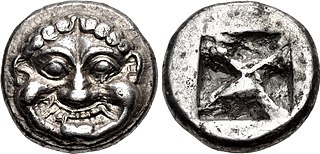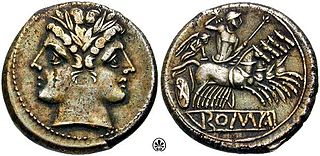
The denarius was the standard Roman silver coin from its introduction in the Second Punic War c. 211 BC to the reign of Gordian III, when it was gradually replaced by the antoninianus. It continued to be minted in very small quantities, likely for ceremonial purposes, until and through the Tetrarchy (293–313).

The history of ancient Greek coinage can be divided into four periods: the Archaic, the Classical, the Hellenistic and the Roman. The Archaic period extends from the introduction of coinage to the Greek world during the 7th century BC until the Persian Wars in about 480 BC. The Classical period then began, and lasted until the conquests of Alexander the Great in about 330 BC, which began the Hellenistic period, extending until the Roman absorption of the Greek world in the 1st century BC. The Greek cities continued to produce their own coins for several more centuries under Roman rule. The coins produced during this period are called Roman provincial coins or Greek Imperial Coins.

The quadrigatus was a medium-sized silver coin produced by the Roman Republic during the 3rd century BC. The obverse featured a young janiform bust and the reverse featured Victory driving a quadriga, giving the coin its Roman name, with the inscription "ROMA" below.
Roman Republican currency refers to the coinage struck by the various magistrates of the Roman Republic, to be used as legal tender. In modern times, the abbreviation RRC, "Roman Republican Coinage" originally the name of a reference work on the topic by Michael H. Crawford, has come to be used as an identifying tag for coins assigned a number in that work, such as RRC 367.

Michael Grant was an English classicist, numismatist, and author of numerous books on ancient history. His 1956 translation of Tacitus's Annals of Imperial Rome remains a standard of the work. Having studied and held a number of academic posts in the United Kingdom and the Middle East, he retired early to devote himself fully to writing. He once described himself as "one of the very few freelancers in the field of ancient history: a rare phenomenon". As a populariser, his hallmarks were his prolific output and his unwillingness to oversimplify or talk down to his readership. He published over 70 works.
A moneyer is a private individual who is officially permitted to mint money. Usually the rights to coin money are bestowed as a concession by a state or government. Moneyers have a long tradition, dating back at least to ancient Greece. They became most prominent in the Roman Republic, and continued into the Empire. In Rome the position of Triumvir Monetalis, held by three people at a time, was a minor magistracy awarded by the Senate, often the first office held by young politicians, including Marcus Aurelius.
Faustus Cornelius Sulla was a politician of the Roman Republic. He was the son of the dictator Lucius Cornelius Sulla. He started his career in the shadow of Pompey, whom he followed during the Civil War against Julius Caesar. He was killed soon after the battle of Thapsus in 46 BC.

The gens Aquillia or Aquilia was a plebeian family of great antiquity at ancient Rome. Two of the Aquillii are mentioned among the Roman nobles who conspired to bring back the Tarquins, and a member of the house, Gaius Aquillius Tuscus, was consul in 487 BC.
Aes grave is a term in numismatics indicating bronze cast coins used in central Italy during the 3rd century BC, whose value was generally indicated by signs: I for the as, S for semis and pellets for unciae. Standard weights for the as were 272, 327, or 341 grams, depending upon the issuing authority.

The triumvir monetalis was a moneyer during the Roman Republic and the Empire, who oversaw the minting of coins. In that role, he would be responsible for the "ordinary coinage" during the republican period. Roman moneyers almost always acted together as a board of three, hence their title triumvir.
Gaius Hostilius Mancinus was a politician and general of the Roman Republic. He is mostly known for his defeat against the Numantines as consul in 137 BC and the humiliating treaty he signed afterwards in order to save his army.
Damastion was an ancient city in the area of central Balkans, known for its silver coins dating back to the 4th century BC. It is attested only in Strabo who says that the city had silver-mines and locates it in Illyria. The ancient author reports that the city was under the authority of the Illyrian tribes of Dyestes and Enchelei, and that Aegina colonized it. At 356–358 B.C. the mines came under the control of Macedon.

The gens Caedicia was a plebeian family at ancient Rome. Members of this gens first came to prominence in the early decades of the Republic, but none obtained the consulship until Quintus Caedicius Noctua in 289 BC. The family faded from public life during the later Republic, but one of the Caedicii was known to Juvenal, toward the end of the first century AD.

The Cheste hoard is an Iberian hoard discovered near the town of Cheste, Valencia, Spain, in 1864. Dating to about 200 BCE, the hoard was found buried in two pots and contained gold jewellery, silver coins and silver ingots. It is currently held in the Valencia History Museum.

The gens Memmia was a plebeian family at ancient Rome. The first member of the gens to achieve prominence was Gaius Memmius Gallus, praetor in 172 BC. From the period of the Jugurthine War to the age of Augustus they contributed numerous tribunes to the Republic.
Harold Mattingly was a British classical scholar, specialising in art history and numismatics. His interests included the history of Ancient Rome, Etruscan and Roman currency, and the Roman historian Tacitus.
Martin Jessop Price was a British numismatist who was made a Merit Deputy Keeper of the British Museum in 1978, a corresponding member of the German Archaeological Institute and was a visiting fellow at the Institute for Advanced Study in Princeton, New Jersey, 1986-87. In 1992 he was awarded the medal of the Royal Numismatic Society. He was educated at King's School, Canterbury and Queens' College, Cambridge, where he graduated with a firsts in classics. In 1961, he won a Greek government scholarship which introduced him to the British School of Athens. In 1966, he was appointed Assistant Keeper in the Department of Coins and Medals at the British Museum, under Kenneth Jenkins, and was eventually appointed Deputy Keeper in 1978 which is a position he held until September 1994 when he became Director at the British School of Athens until his death.

Andrew Michael Burnett, is a British numismatist and museum curator, who specialises in Roman coins. He was Deputy Director of the British Museum from 2003 to 2013, and Keeper of its Department of Coins and Medals from 1992 to 2003. He was president of the Royal Numismatic Society from 2013 to 2018.

Suzanne Frey-Kupper is a classical archaeologist and numismatist from Switzerland, who is Professor of Classics and Ancient History at the University of Warwick. She specialises in the study of Greek, Roman and Punic coinage, in particular examining their role in historical processes and as social agents.










